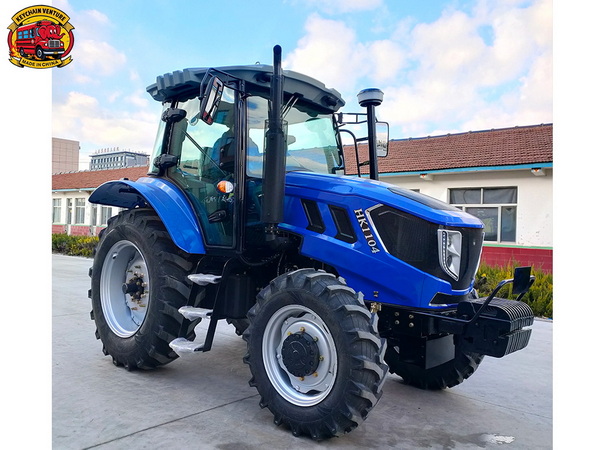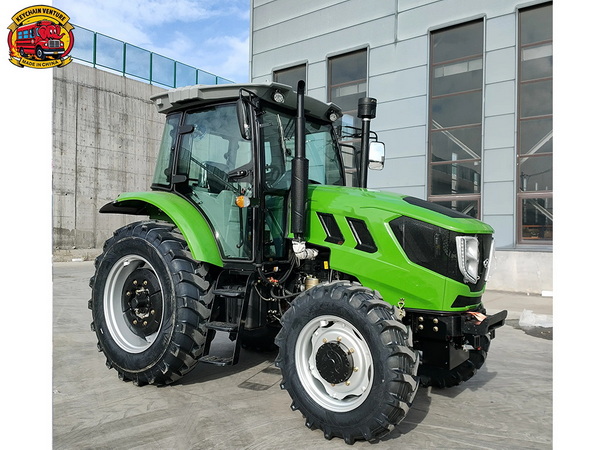Views: 222 Author: Amanda Publish Time: 2025-10-30 Origin: Site








Content Menu
● Lifespan by Tractor Category
● Factors That Influence Tractor Longevity
>> 5. Storage and Seasonal Rest
● Evaluating a Used Tractor by Hours
● Light, Moderate, and Heavy Use Explained
● Importance of Preventive Maintenance
● Technological Advancements in Modern Tractors
● Electric and Hybrid Tractors: Redefining “Hours”
● When to Rebuild or Replace a Tractor
● Managing Tractor Fleets for Business Efficiency
● The Human Element: Operator Training and Awareness
● Environmental and Regulatory Considerations
● Productivity Optimization Tips
● Global Durability Comparison
● Tractor Hours and Return on Investment
● FAQ
>> 1. What counts as high hours on a tractor?
>> 2. How can I make my tractor last longer?
>> 3. Are electric tractors more durable than diesel ones?
>> 4. Should I buy a used tractor with 6,000 hours?
>> 5. How do idle hours affect total tractor lifespan?
For farmers, contractors, and fleet managers, a tractor is more than just a machine—it's the backbone of every agricultural and industrial operation. Whether working in vast farmlands, construction zones, or logistics hubs, understanding how many hours is “a lot” for a tractor determines its value, efficiency, and replacement schedule. This question isn't about a fixed number—it's about how you use, service, and preserve the tractor over time.

A tractor's hour meter functions similarly to a car's odometer—it measures the amount of time the engine has been running, not the distance traveled. However, since tractors operate under highly variable workloads, hours can have different meanings depending on the task. A tractor used to pull heavy loads for 500 hours a year may suffer more wear than another that idles or runs light equipment for twice that time.
Generally speaking:
- Compact tractors (under 50 horsepower): Moderate use equals 100–500 hours annually.
- Utility tractors (50–100 horsepower): Usually log 400–750 hours per year.
- Heavy-duty tractors (above 100 horsepower): Can safely handle 800–1,200 hours or more each year.
A well-cared-for tractor can function effectively for 6,000 to 10,000 hours before a major rebuild is required, though premium models and those maintained meticulously can cross the 15,000-hour mark with consistent output.
Tractor Type | Typical Lifespan (Hours) | Common Applications |
Compact Tractor | 3,000–6,000 | Landscaping, small-acre farms |
Utility Tractor | 5,000–9,000 | Medium-sized farms, transport |
Agricultural Tractor | 6,000–12,000+ | Large-scale farming, tilling |
Industrial Tractor | 8,000–15,000+ | Construction, excavation, heavy roadwork |
Specialty Tractor | Variable | Vineyard work, forestry, slope operations |
While these figures offer a framework, maintenance history and operator habits often prove more important than the hour meter itself.
Routine care defines the difference between a short-lived and a lifetime tractor. Basic actions like replacing oil and hydraulic filters, keeping radiators clean, and using manufacturer-approved fluids add thousands of safe working hours.
Tractors working in dusty, saline, or humid regions deteriorate faster. Sealing mechanical joints, regular greasing, and end-of-day cleaning minimize corrosion and mechanical fatigue.
Experienced drivers protect machines unconsciously—they avoid over-revving, select the right gear for the load, and allow the engine to warm up before heavy work begins.
Contaminated or low-grade fuel can quickly harm injectors, pistons, and valves. Frequent fuel filter changes and sourcing diesel from trusted stations help extend overall tractor life.
Proper storage during off-seasons matters greatly. Protecting tractors indoors keeps moisture, rodents, and rust at bay, ensuring the machine starts reliably after months of downtime.
When buying a used tractor, you must interpret the hour meter wisely. A 6,000-hour tractor can be a great purchase or a problematic one depending on previous upkeep. Consider these signs of a healthy machine:
- Even engine sound during idle and acceleration
- Minimal smoke and clean oil residue
- No visible leaks or overheating issues
- Smooth clutch engagement and consistent hydraulic pressure
- Comprehensive maintenance logbook
Hours only tell part of the story. It's the tractor's service history, workload type, and original operating environment that truly determine its worth.
Usage Level | Hours per Year | Common Traits |
Light Use | Below 300 | Often for hobby farming or landscaping; minimal wear |
Moderate Use | 300–800 | Full-season agricultural use; requires regular maintenance |
Heavy Use | Above 800 | Commercial-scale operation; high component turnover expectancy |
A 10-year-old tractor with 4,000 hours may be far superior to one with the same age but double the hours if it received proper service throughout its life.
Preventive maintenance ensures your tractor delivers consistent performance. Here's a suggested schedule:
- Every 100 hours – Replace engine oil and filters, check belts and tire pressure.
- Every 250–300 hours – Inspect coolant system, lubricate all pivot points, check fuel system integrity.
- Every 500 hours – Inspect brakes, transmission oil, and hydraulic filters.
- Annually – Conduct a full mechanical inspection including compression tests and diagnostic scans.
Such consistency could easily add 3,000+ more operating hours to your tractor's lifespan.

Tractor technology has advanced dramatically in recent years. Leading brands now incorporate smart diagnostic systems, telematics, and predictive analytics that log every operational detail. For example:
- Telematics monitor fuel consumption, engine load, and idling ratios.
- GPS guidance improves accuracy in plowing, reducing operator fatigue.
- Auto-maintenance alerts signal when filters need replacing or oil viscosity decreases.
This ecosystem of integrated sensors transforms maintenance from reactive to proactive, reducing downtime and optimizing efficiency.
As the agricultural sector moves toward electrification, electric and hybrid tractors introduce a new dimension—battery cycles replace traditional engine hours as the measure of lifespan.
Electric tractors:
- Operate quietly with fewer moving parts.
- Have lower vibration and heat generation.
- Require minimal routine maintenance.
While battery degradation becomes the new concern, these models promise operating lifespans comparable to 10,000+ engine hours under regular diesel standards.
A tractor typically signals it's nearing the end of its optimal life when:
- Engine oil consumption dramatically increases.
- Compression readings fall below standards.
- Hydraulic systems show sluggish reaction or continuous leaks.
- It emits smoke under medium load or generates overheating alerts frequently.
A rebuild rejuvenates mechanical components at roughly half the cost of a new machine, whereas replacement ensures higher efficiency and compliance with modern emission norms.
Businesses often run cost-benefit analyses—if maintenance costs start surpassing operational returns, upgrading becomes the smarter move.
Large operators like KeyChain Venture Co., Ltd., a pioneer in commercial vehicles and heavy equipment solutions, apply data analytics to monitor tractor hour cycles across entire fleets. This practice ensures every machine operates within its most productive window.
Fleet managers rely on hour-to-output ratios: when a tractor's productivity begins to plateau or maintenance costs rise steeply, the transition plan to newer units begins. Maximizing tractor performance means finding that balance point where reliability, fuel efficiency, and operating hours intersect efficiently.
Even the strongest machinery can fail prematurely if operators aren't properly trained. A skilled operator:
- Understands PTO (Power Take-Off) safety and loading limits.
- Avoids unnecessary idling.
- Knows how to balance weight distribution on slopes.
- Monitors gauge readings continuously during operation.
In contrast, improper braking technique, gear misuse, or overloading can shave thousands of working hours off a tractor's potential lifespan.
Sustainability plays an increasing role in modern fleet operations. Aged tractors, while mechanically capable, usually emit higher carbon and particulate levels. Regulations in many countries now mandate upgrades or retrofits to deter pollution.
Adopting new-generation engines or hybrid-electric systems not only reduces emissions but also improves operating efficiency by 10–20%, ultimately extending tractor longevity.
To ensure every tractor hour contributes maximum value:
- Keep detailed hour logs for maintenance forecasts.
- Alternate work between tractors in a fleet to prevent uneven aging.
- Maintain correct tire inflation to reduce rolling resistance.
- Periodically recalibrate implements to ensure balanced power distribution.
- Schedule work during optimal soil and weather conditions to prevent engine strain.
This holistic approach turns “hours” into productive, profitable units rather than wear indicators.
Country | Average Operational Life Before Overhaul | Key Observation |
United States | 8,000–10,000 hours | Regular preventive maintenance culture |
Germany | 10,000–12,000 hours | Advanced engineering and strong service support |
China | 6,000–9,000 hours | Rapidly modernizing fleets with efficient parts supply |
India | 5,000–8,000 hours | Intense workloads and climatic challenges |
Australia | 8,000–11,000 hours | Emphasis on endurance and environmental resilience |
Calculating ROI involves comparing total earning or production capacity against ownership costs.
Formula example:
ROI=(Total Output Value – Operating Costs)/Operating Costs×100
Applying this to tractor hours helps businesses know exactly when replacement is financially justified rather than solely mechanical.
The definition of “a lot” of hours for a tractor is fluid—it depends on how effectively the tractor has been used, serviced, and preserved. A 10,000-hour tractor maintained with care can often outperform a 4,000-hour machine that's been neglected.
Modern designs, digital monitoring systems, and disciplined operation are changing how owners perceive tractor longevity. It's no longer about reaching a certain number; it's about sustaining peak performance throughout those hours. With strategic maintenance and responsible use, a tractor can serve as a reliable partner for decades, ensuring productivity, sustainability, and strong returns for every working hour.

Anything above 8,000 hours may be considered high, but with careful maintenance and proper handling, tractors can exceed that figure without losing reliability.
Follow your manufacturer's service intervals, store the tractor under cover, and use only approved oils and filters.
They can be, thanks to fewer moving parts and cleaner energy systems. However, long-term durability depends on battery health.
Yes, if the price is fair and it has a strong service record. A mechanic's inspection is always recommended beforehand.
Idle hours contribute to engine wear even though no productive work is done. Minimizing idling improves engine condition and fuel efficiency.